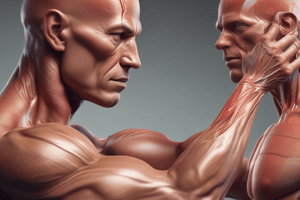Podcast
Questions and Answers
What is a common symptom of a muscle strain?
What is a common symptom of a muscle strain?
- Inability to use the muscle
- Intense, localized pain
- Minimal loss of strength and function
- Severe pain, swelling, and bruising (correct)
What characterizes a Grade 2 muscle strain?
What characterizes a Grade 2 muscle strain?
- Minor stretch or tear with no function loss
- Excessive stiffness without injury
- Partial tear with moderate loss of strength (correct)
- Complete tear of muscle fibers
Which of the following is a common cause of tendinitis?
Which of the following is a common cause of tendinitis?
- Repetitive motion and poor form (correct)
- High impact trauma
- Muscle cramps during activity
- Direct injury from sports
What is a primary method to prevent muscle strains?
What is a primary method to prevent muscle strains?
Which injury involves inflammation of the bursa sacs?
Which injury involves inflammation of the bursa sacs?
Which exercise is NOT recommended for strengthening the hamstrings?
Which exercise is NOT recommended for strengthening the hamstrings?
What is a primary benefit of cross-training in sports activities?
What is a primary benefit of cross-training in sports activities?
How does maintaining a healthy weight contribute to injury prevention?
How does maintaining a healthy weight contribute to injury prevention?
Which exercise is NOT part of the core strengthening routine recommended for injury prevention?
Which exercise is NOT part of the core strengthening routine recommended for injury prevention?
What aspect of physical training can significantly reduce injury risk?
What aspect of physical training can significantly reduce injury risk?
Flashcards are hidden until you start studying
Study Notes
Muscle Injuries
- Muscle Strain: Overstretching or tearing of muscle fibers.
- Causes: Sudden forceful contraction, repetitive use.
- Symptoms: Pain, swelling, bruising, weakness.
- Grading:
- Grade 1: Minor stretch, minimal loss of strength and function.
- Grade 2: Partial tear, moderate loss of strength and function.
- Grade 3: Complete tear, significant loss of strength and function.
- Common Sites: Hamstrings, quadriceps, calf muscles, back muscles.
- Risk Factors: Lack of flexibility, muscle imbalances, poor conditioning.
- Muscle Tear: Partial or complete tearing of muscle fibers.
- Causes: Sudden forceful contraction, high impact trauma.
- Symptoms: Severe pain, swelling, bruising, inability to use muscle.
Tendon Injuries
- Tendinitis: Inflammation of a tendon, often from overuse.
- Causes: Repetitive motion, poor form, sudden increase in activity.
- Symptoms: Pain, swelling, stiffness.
- Tendon Tears:
- Partial Tears: Some tendon fibers damaged, but not completely ruptured.
- Complete Tears: Tendon fully severed, often require surgical repair.
- Causes: Sudden trauma or gradual degeneration.
- Recovery: Involves rest, physical therapy, and sometimes surgery.
- Bursitis: Inflammation of fluid-filled bursa sacs cushioning joints.
- Common Sites: Shoulder, elbow, hip, knee.
- Causes: Repetitive motion, direct trauma, underlying conditions like arthritis.
- Symptoms: Pain, swelling, stiffness, decreased range of motion.
Preventing Muscle and Tendon Injuries
- Proper Warm-up and Cool-down: Helps increase blood flow and prepare muscles and tendons.
- Gradually Increase Activity Levels: Avoid sudden increases in activity to prevent excessive strain.
- Strength Training: Builds strength in muscles and tendons. Focus on exercises specific to activities and muscle groups.
- Flexibility and Mobility Work: Improves flexibility in muscles and mobility in joints.
- Proper Technique and Form: Reduces strain on muscles and tendons. Seek guidance from a coach or trainer.
- Cross-Training: Varies activities to avoid overuse of the same muscle groups.
- Adequate Rest and Recovery: Allows muscles and tendons to recover between workouts. Prioritize sleep and stress management.
- Maintain a Healthy Weight: Reduces the load and strain on the musculoskeletal system.
Strength Training Exercises for Injury Prevention
- Hamstrings:
- Nordic hamstring curls
- Deadlifts
- Leg curls
- Glute bridges
- Quadriceps:
- Squats
- Lunges
- Step-ups
- Wall sits
- Calf Muscles:
- Calf raises (seated & standing)
- Jump training
- Heel drops
- Rotator Cuff:
- Shoulder external rotation
- Rear delt flyes
- Face pulls
- Band pull-aparts
- Core:
- Planks (front, side, reverse)
- Dead bugs
- Pallof presses
- Wood chops
- General Lower Body Strength:
- Hip thrusts
- Step-ups
- Lateral lunges
- Single-leg RDLs
Studying That Suits You
Use AI to generate personalized quizzes and flashcards to suit your learning preferences.




